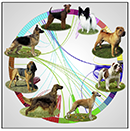Dog Genes Tell Surprising Tales
Streamed live on Apr 6, 2017...
Dr. Ostrander’s team has taken advantage of naturally occurring variations in dog populations in order to reveal the genetic mechanisms underlying both simple and complex traits. She will show how findings related to the genetic basis for canine disease, behavior, and morphologic traits frame our thinking of human growth regulation, disease, and population migration.
Edited by Ann Milligan

Recommended Comments
Please sign in to comment
You will be able to leave a comment after signing in
Sign In Now